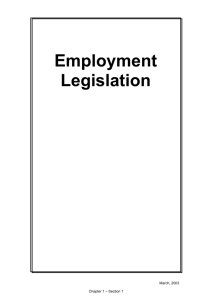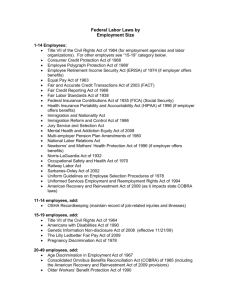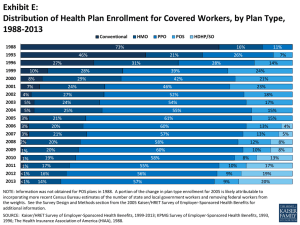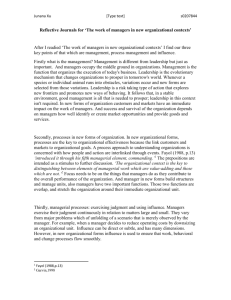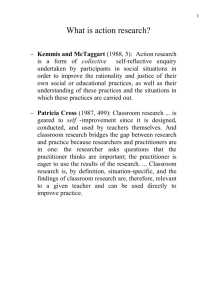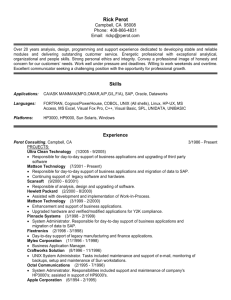Assuring the Health of the Public in the 21st Century
advertisement
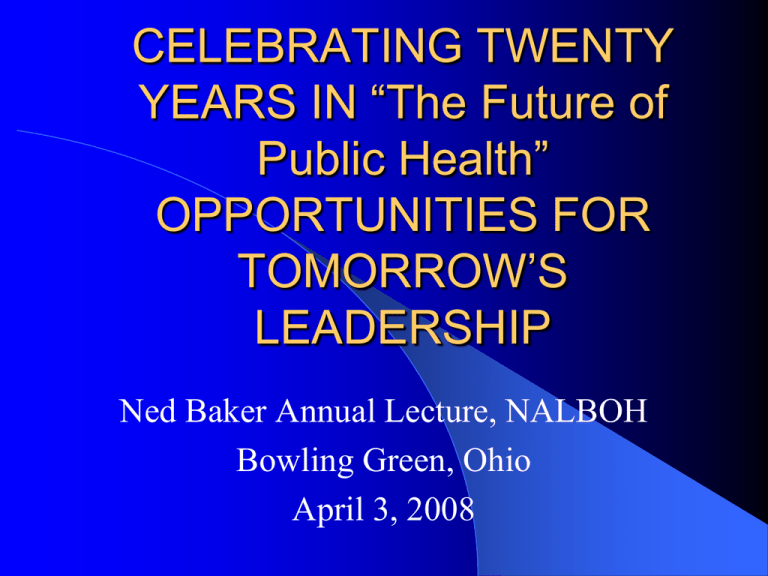
CELEBRATING TWENTY YEARS IN “The Future of Public Health” OPPORTUNITIES FOR TOMORROW’S LEADERSHIP Ned Baker Annual Lecture, NALBOH Bowling Green, Ohio April 3, 2008 CELEBRATING TWENTY YEARS IN ‘THE FUTURE OF PUBLIC HEALTH’ Hugh H. Tilson MD, DrPH Public Health Leadership Program UNC School of Public Health and Member of the Panel, IOM, 1988 But FIRST … a word about the Health of the Public in the 21st Century “The Future of the Public’s Health” 2003 A Report from the Institute of Medicine Follow-up Study of the 1988 “Future of Public Health” and its implications for NALBOH’s Public Health Leadership THE FUTURE OF THE PUBLIC’S HEALTH in the 21st Century INSTITUTE OF MEDICINE OF THE NATIONAL ACADEMIES Committee on Assuring the Health of the Public in the 21st Century What’s “ASSURING”?? Whaddya’ mean “keeping pace”? In THIS mess? We regret that the program … originally scheduled for this time … could not be CANCELLED!! The National Academies The National Academy of Sciences (1863) The National Research Council (1916) The National Academy of Engineering (1964) The Institute of Medicine (1970) Why a new study about the future of public health? NOT BECAUSE THE ‘OLD’ REPORT WAS WRONG Why a new study about the future of public health? NOT BECAUSE THE ‘OLD’ REPORT WAS WRONG …IN FACT, IT IS ‘EVERGREEN’!! IOM’s LANDMARK REPORT ON “THE FUTURE OF PUBLIC HEALTH” 1988 CELEBRATING TWENTY YEARS OF PROGRESS: 1988-2008 Why a new study about the future of public health? NOT BECAUSE THE ‘OLD’ REPORT WAS WRONG … IT IS ‘EVERGREEN’!! And DEFINITELY worth a careful look The LANDMARK report on the “Future of the Public Health” IOM 1988: BACKGROUND --The Swine Flu fiasco of 1976 --The Model Standards for Community Preventive Health Services weak response --The inability of the local infrastructure to respond to the Model Standards --The crumbling of Federal support --The politicization of the Federal Public Health leadership The 1988 Panel 21 of the Brightest and the Best (plus me) All the right domains represented All the public health professions Elected officials Superb high level professional staffing Adequate resources … Kellogg, CDC, HRSA funding The 1988 Report: the approach “check your assumptions at the door” Used classic social science methods … broad fact finding, literature reviews, expert testimony, and field site visits Asked: what is your definition of public health Used: “tracers”: what was the problem, what did you do about it, who made it happen? 1988: The Big News “… this nation has lost sight of its public health goals and has allowed the system of public health activities to fall into DISARRAY!” 1988: the critical reconception of public health “The committee defines the mission of public health as fulfilling society’s interest in assuring conditions in which people can be healthy” “The committee finds that the core functions of public health agencies at all levels of government are assessment, policy development, and assurance” 1988: the Core Functions Assessment: … regularly and systematically collect, assemble, analyze, and make available information on the health of the community … Policy Development: … Agencies must take a strategic approach, developed on the basis of a positive appreciation for the democratic political process 1988: The core functions Assurance: … assure their constituents that services necessary to achieve agreed upon goals are provided … encouraging actions by other entities …. Requiring such action through regulation, or by providing services directly … a set of high-priority personal and communitywide health services that governments will guarantee to every member … IOM 1988: Recommendations States: “… are and must be the central force in public health” Localities: “no citizen from any community, no matter how small or remote, should be without identifiable and realistic access to the benefits of public health protection, which is possible only through a local component of the public health delivery system.” “the AGPALL” concept 1988: Fulfilling the Government Role: Implementing Recommendations Statutes: … reform; delineate responsibilities and authorities and a core set of functions Organizational Structure: … an identifiable state department of public health … state health council .,.. Establish standards for local public health functions 1988: Organizational Structure Localities: “… the larger the population served by a single multipurpose government, as well as the stronger the history of local control, the more realistic … promote local accountability 1988: Organizational Structure Localities: “… the larger the population served by a single multipurpose government, as well as the stronger the history of local control …… clear focal point: “where the scale of local government activity permits, localities should establish public health councils to report to elected officials on local health needs and on the performance of the local health agency.” (NOTE TO NALBOH … what happened THREE years after this recommendation?) 1988: Special linkages Environmental health Mental Health Social Services Care of the indigent: “… until adequate federal action is forthcoming, public health agencies must continue to serve …to the best of their ability, the priority personal health care needs of the uninsured, underinsured, and Medicaid clients.” 1988: Strategies for Capacity Building Technical: uniform data set; Institutional home for new knowledge; research Political: relationships with elected officials; competence in community relations; working partnerships and support among local, state, and national medical and professional societies … 1988: Strategies for Capacity Building Managerial: … training … on managerial and leadership skills; demonstrated management competence … should be a requirement; salaries and benefits Programmatic: … more emphasis on “factors that influence health-related behavior …” Fiscal: … Fed to State and State to local, with incentives and sanctions 1988: Education for Public Health Schools … firm practice links; resources to governments; students “an opportunity to learn the entire scope of public health practice”; research … applied and implementation; full advantage of other faculties; full support to other faculties Education programs … should be informed by comprehensive and current data on public health personnel…” Why a new study about the future of public health ? 2000: IOM commissioned a systematic review of progress as part of its commitment to followIO through. Progress was dramatic on every front. However, challenges and frustrations abounded as well. Why a new study about the future of public health ? IOM commissioned a systematic review: PROGRESS is IMPRESSIVE IO Conceptualization: The public health working group and the ten essential services Organization: NACCHO, NALBOH, Council on Linkages Workforce: PHLI, Management Academy Why a new study about the future of public health in 2000-2003? Still, due to the rapidly changing (“flat”) world, public health systems were under greater stress than ever before Additionally, these changes bring increasingly diverse demands, expectations, opportunities, and resources for public health Oh, yes … and then there’s the MONEY $$$$$$$$$$$$$$$$$$$ WE interrupt this program for the following announcement Why a new study about the future of public health in 2003? And then came September 11th … And the Anthrax attacks that followed … that changed ‘everything’ … and for the IOM Committee, the urgency for a report to galvanize to concerted action was CLEAR Why talk about a twenty year old and a five year old study about the future of public health HERE/NOW? …because the Nation and States need help from our leadership …a.k.a. YOU ! But first... a word from our sponsors! The 2003 study sponsors Centers for Disease Control and Prevention (CDC) National Institutes of Health (NIH) Substance Abuse and Mental Health Services Administration (SAMHSA) Office of the Secretary, Assistant Secretary for Planning and Evaluation (OS/ASPE) Health Resources and Services Administration (HRSA) Office of Disease Prevention and Health Promotion (ODPHP) Assuring the Health of the Public in the 21st Century Who? The 2003 Committee Jo Ivey Boufford Christine Cassel Kaye Bender Lisa Berkman JudyAnn Bigby Thomas Burke Mark Finucane George Flores Lawrence Gostin Pablo Hernandez Judith Lave John Lumpkin Patricia Peyser George Strait Thomas Valente Patricia Wahl Gail Warden Hugh Tilson (Liaison) George Isham (Liaison) Assuring the Health of the Public in the 21st Century Who? What? When? Where? How? Addressing the charge required...JUST WHAT YOU REQUIRE TODAY … Methodology Literature review on all relevant topics Hearings and expert testimony at Committee meetings Input from the Committee’s Liaison Panel and from the general public Qualitative and quantitative data from Federal, state, and local public health systems State and local community organizations National and professional organizations Site visits Futures visioning and scenario building Today’s forecast is limited by lack of vision …. Futures visioning and scenario building The committee examined the drivers, or the forces that are likely to shape the future, and used “visioning” to generate scenarios, or potential realities for which public health must be prepared. Futures visioning and scenario building The committee ascertained the drivers, or the forces that are likely to shape the future, and used visioning to generate scenarios, or potential realities for which public health must be prepared. .. AND a great way for YOU to LEAD, too” Some important “drivers” of population health Changes in the environment Infectious disease threats Advances in biotechnology and information technology Disparities in health status and access to care Globalization A social and political environment that prioritizes health Some important “drivers” of population health Changes in the environment Infectious disease threats Including MANMADE ONES!! Advances in biotechnology and information technology Disparities in health status and access to care Globalization A social and political environment that prioritizes health Public health is preparing for whatever comes next. Some important “drivers” of population health Changes in the environment Infectious disease threats Including MANMADE ONES!! Advances in biotechnology and information technology glumbert/media/shift Disparities in health status and access to care Globalization A social and political environment that prioritizes health THE FUTURE OF THE PUBLIC’S HEALTH in the 21st Century INSTITUTE OF MEDICINE OF THE NATIONAL ACADEMIES WWW.NAP.EDU The Context for the Report 1988 report is ‘evergreen’ and there is GREAT National Health Achievement in the 20th Century BUT … US falling short in international comparisons Poor return on investment in health Concern about the government public health infrastructure’s ability to meet future health challenges, both local and global Background in the Report Health = Public Good Government has fundamental, statutory duty to assure the health of the public Background in the Report Health = Public Good “Without Health there can be no happiness” (attributed to Thomas Jefferson IOM p xi) Government has fundamental, statutory duty to assure the health of the public Background in the Report Health = Public Good Government has fundamental, statutory duty to assure the health of the public, BUT … Government cannot do it alone Need for inter-sectoral engagement in partnership with government (the 1988 report mission statement is indeed EVERGREEN!) Health = social goal of many sectors and communities The root causes of ill health must be addressed by many outside the public health system The Committee’s Conclusion An inter-sectoral public health system is needed In 1988 report, public health refers to the “organized efforts of society, both government AND OTHERS, to assure conditions in which people can be healthy” THIS report elaborates on the efforts of the other potential public health system actors. The Committee’s Vision The committee adopts as its vision the vision of Healthy People 2010: Healthy People in Healthy Communities NOTE: The committee explicitly elected NOT to ‘re-discover the wheel’ … a good principle to keep the pace! MAJOR opportunities for NALBOH from the 1988 and 2003 IOM Reports The SYSTEM components and their roles The TEN Essential Services Core Competencies Public Health SYSTEM Performance Standards Certification Accreditation Really embracing the “SYSTEM” as proposed by the 1988 report The Committee’s Conception: The Public Health SYSTEM!! The Official Public Health Agency Infrastructure The Medical Care System The Media Academia The Community The Private Sector/Industry What is the Public Health System? More than just the public health agency “Public health system” – All public, private, and voluntary entities that contribute to the delivery of public health services within a jurisdiction. Community Governmental Public Health Infrastructure Health care delivery system Assuring the Conditions for Population Health Academia Employers and Business The Media (IOM, 2003) The Public Health System … … GREAT progress since 1988 …”Despite this progress, the Committee found that in many important ways, the public health system that was in disarray in 1988 remains in disarray today.” The Public Health System … And so how can NALBOH’s members help public health agencies to gain the status, recognition, and respect to lead the system while we must “run the business…”? NALBOH in the lead: putting the essential in “ESSENTIAL SERVICE”?? The Essential Public Health Services building on 1988 9. Evaluate health services Monitor health status 2. Diagnose and investigate health problems 3. Inform and educate 4. Mobilize communities to address health problems 5. Develop policies and plans 6. Enforce laws and regulations 7. Link people to needed health services 8. Assure a competent health services workforce 1. 10. Conduct research for new innovations THE TEN Essential Services Monitor health status … Diagnose and investigate health problems .. Inform, educate and empower people … Mobilize community partnerships … Develop policies and plans that …. “My Day Is Made Pushing …” THE TEN Essential Services (cont) Enforce laws and regulations … Link people to needed personal health svcs.. Assure a Competent public health AND personal health care workforce Evaluate effectiveness, accessibility and quality of personal and population based Services Research for new insights and innovative solutions to health problems …”Everything Likely to Win Some Resources!!” NALBOH leadership: finding the core in “CORE COMPETENCY”?? THE EIGHT Core Competencies (Council on Linkages building on 1988) Analytic/Assessment Skills Policy Development/program planning Communication Cultural Competency Community Dimensions of Practice Basic Public Health Sciences Financial Planning and Management Leadership and Systems Thinking THE EIGHT Core Competencies and CERTIFICATION What are the credentials needed to work in the public health system? How can these be tied to competencies? How should we go about documenting competency to practice? If “certification”, how should we certify, and whom, and for what? THE EIGHT Core Competencies and CERTIFICATION What are the credentials needed to work in the public health system? How can these be tied to competencies? How should we go about documenting competency to practice? If “certification”, how should we certify, and whom, and for what? What challenges lie ahead for the “American Board of Public Health”? THE EIGHT Core Competencies and CERTIFICATION AND MOST IMPORTANT: HOW CAN WE DO ALL OF THIS WHILE ADDRESSING THE CRITICAL WORKFORCE SHORTAGE FOR PUBLIC HEALTH IN THE DECADE AHEAD?? NALBOH in the leadership: using the “system performance standards” The National PH Performance Standards Program(NPHPSP) building directly on the Model Standards in the 1988 report THREE “instruments” OMB approved with ‘control numbers’ STATE LOCAL GOVERNANCE Four Concepts Applied in NPHPSP Based on the ten Essential Public Health Services 2. Focus on the overall public health system 3. Describe an optimal level of performance 4. Support a process of quality improvement 1. The local public health system assessment instrument OMB Control Number 0920-0555 24 hours per response “…ALL entities that contribute to the delivery …” The local public health system assessment instrument “How much of this Model Standard is achieved by the local PHS collectively?” What percent of the answer reported in Q 1 is the direct contribution of the local PH agency? The local public health system assessment instrument For the LPHS … asks about GOVERNANCE For the GOVERNANCE instrument, critical issues to NALBOH include … Mobilizing for Action through Planning and Partnerships (MAPP) Developed by NACCHO and CDC Based on the 1988 recommendations, development began in 1996, released in 2001 Community strategic planning tool Web-based tool – www.naccho.org NPHPSP and MAPP NPHPSP Local Instrument used within MAPP to assess public health system capacity MAPP provides the process for addressing weaknesses and building on strengths NACCHO Operational Definition of a Functional Local Health Department Co-funded by CDC and RWJF Goal: Shared understanding of what people can reasonably expect from LHDs Builds on the “AGPALL” 1988 Framed around the ten Essential Services but presented in more common language Accommodates variety in LHD structure and governance “Public health is a complex concept, but the operational definition can help dispel the mystery. Eventually public health can be recognized and valued even when—particularly when— things are going well.” Susan Gerard Director, Arizona Department of Health Services Public health is a complex concept and so we need to develop a meaningful identifiable BRAND IOM Reports 1988/2003 – National Catalyst for Accreditation Establish a “national commission to explore accreditation” Further states… – “This (accreditation) commission should focus on the development of a system that will further the efforts of NPHPSP.” Building on the 1988 recommendations: Exploring Accreditation Co-funded by CDC and RWJF Jointly led by NACCHO, ASTHO, NALBOH and APHA Informed by the Multi-State Learning Collaborative Model addressed governance, standards, financing and incentives, and evaluation Model for voluntary accreditation developed and approved Accreditation for state and local health departments is both desirable and feasible! THE TEN Essential Services (cont) Enforce laws and regulations … Link people to needed personal health svcs.. Assure a Competent public health AND personal health care workforce Evaluate effectiveness, accessibility and quality of personal and population based Services Research for new insights and innovative solutions to health problems Oh, yes … and number ELEVEN: Governance and management of heath department resources Public health system assessment instruments and A CCREDITATION Can achievement of a “passing grade” on a performance assessment be used for accreditation? How should WHO accredit WHOM and HOW? (not to mention WHY?) Public health system assessment instruments and ACCREDITATION Can achievement of a “passing grade” on a performance assessment be used for accreditation? How should WHO accredit WHOM and HOW? (not to mention WHY?) SEE: “Exploring Accreditation” and CDC’s NPHPSP website Public health system assessment instruments and ACCREDITATION AND MOST IMPORTANT, HOW CAN WE KEEP ON TOP OF THE SPECIFIC HEALTH CHALLENGES WHILE WE TEND TO THE INFRASTRUCTURE ?? LEADERSHIP Questions for NALBOH: How can Essential Services, Competencies, and Performance Standards inform accreditation and certification? Especially NOW!! Essential Services=Essential, Competencies=Unique and necessary, and Performance Standards and a new formulation can inform advocacy for public health! Especially NOW!! Sometimes the best way to lead progress is to take a moment to look back SO … let’s celebrate twenty years of “the future” IOM’s LANDMARK REPORT ON “THE FUTURE OF PUBLIC HEALTH” 1988 THE FUTURE OF THE PUBLIC’S HEALTH in the 21st Century INSTITUTE OF MEDICINE OF THE NATIONAL ACADEMIES … and FIVE years into Assuring the Health of the Public in the 21st Century The best way to predict the future is to CREATE it. (P Drucker) SO .. LET’S TALK… NALBOH’s leadership counts!!! THANKS! BACKUP SLIDES FOLLOW The Public Health System: What We Don’t Know but YOU can help us to find out!! RESEARCH … the tenth “essential service” … ie not someone else’s job Public Health Systems Research … much in need of help but enormous progress (Council on Linkages!) FAILURE to collect the evidence base precludes evidence-based policy (witness the IOM report) The Public Health System: What We Don’t Know but YOU can help us to find out!! What is the optimal allocation of responsibilities among partners? What is the appropriate funding formula for the system? What is the minimal staffing for a competent local official health agency? What is the minimum size below which an efficient/effective infrastructure is not possible? The Public Health System: What We Don’t Know What is the largest population to be served and still be ‘local’? What is the optimal mix of disciplines or competencies in the competent agency? How far is too far away for a local agency? What is the appropriate or optimal relationship between the State Health Agency and the local official agency(ies)? The Public Health System: What We Don’t Know but YOU need to help with! What do we know about governance and what do we need to know? How does this differ across the “five … or is it more? … Americas” What is the evidence for best performance from a Local Agency or Board of Health? How many jurisdictions can a local agency manage or a board of health “govern”? How can public health most effectively relate to local general purpose government? Ahead of the pace … “Who will Keep the Public Healthy?” The PIPELINE is dangerously empty and the audience is dangerously “graying” SO: we needed to assess the past and current state of training and education for public health professionals and develop recommendations for strengthening public health education Companion Study “Who will keep the Public Healthy?” Utilize recommendations and other information from the Assuring the Health report Ten-year look forward Companion Study “Who will keep the Public Healthy? Kristine Gebbie Linda Rosenstock Susan Allan Kaye Bender Dan Blazer Scott Burris Mark Cullen Bob Goodman Alan Guttmacher Rita Kukafka Sheila Smythe Roxanne Parrott Companion Study “Educating Public Health Professionals for the 21st Century” Process and development of recommendations similar to “Future of the Public’s Health” study Final Report issued on November 4 and ‘launched’ at APHA in the late fall 2002! Companion Study “Educating Public Health Professionals for the 21st Century” A MODEL of health that emphasizes the linkages and relationships among multiple factors (or determinants) affecting health is an ECOLOGICAL MODEL” “Educating Public Health Professionals for the 21st Century” KEY Recommendations SIX major responsibilities: Educate the leaders; focal point for Transdisciplinary Research; contribute to policy; collaborate with other schools for public health content; life-long learning; engage actively with various communities to improve the public’s health “Who will Keep the Public Healthy?” Keep the basics; ADD Eight new competencies Epidemiology, Statistics, Health Policy, Environmental Health, Social and Behavioral Sciences Informatics, genomics, communication, cultural competence, community based participatory research , global health, policy and law and public health ethics “Educating Public Health Professionals for the 21st Century” KEY Recommendations Primary Educational Mission: the preparation of individuals for positions of senior responsibility Emphasize the centrality of the ECOLOGIC Approach NEW competencies in genomics, communications, leadership, policy, law and ethics “Who will Keep the Public Healthy?” For EACH of the Eight new content areas Competencies be identified; Each area be included in graduate level public health education; Continuing development and creation of new knowledge be pursued; and Opportunity for specialization be offered. NALBOH … a ‘closing keynote’ … a new time of oppor-TUNE-ity G-minor: Gee, there are certainly some minor problems (ahem!!) getting there B-flat: Be flat-out proud of what our field and this state have already accomplished B-sharp: There are wonderful opportunities ahead, but it will take a trained eye to see them in the current context C-major!! The best way to keep pace with progress is to be ahead of it!! SO .. LET’S TALK… YOUR leadership counts!!! After all, Public Health is a work in progress... I want to hear from YOU NOW … and always! HUGH_TILSON@UNC.EDU
